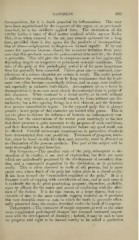Page 883 - My FlipBook
P. 883
GANGRENE. 893
•fleconiposition, for it is death preceded by inflammation. This may
have been superinduced by the exposure of the organ, or, as previously
described, by a too suddenly applied force. The destruction of the
vitality leaves a mass of dead matter confined within narrow limits.
This, even when exposed to the air, may remain quiescent for a long
time, provided there is free egress for the products of decomposition.
One of these—sulphuretted hydrogen—is formed rapidly. If by any
means the aperture becomes closed, the excessive irritation from pres-
sure that this produces rouses the pericementum into activity ; the result
is periostitis. This will give rise to symptoms more or less aggravated,
depending largely on temporary or permanent systemic conditions. The
state of the pulp at this pathological period is of far more importance
than has generally been conceded. Unless great care is exercised, com-
])lications of a serious character are certain to result. The septic poison
so infiltrates the surrounding tissue by long continuance that the treat-
ment very often becomes exceedingly tedious, and in some cases ineffect-
ual, especially in cachectic individuals. Atmospheric air as a factor in
decomposition is in no case more clearly demonstrated than in pulps of
this character. When confined in a sealed cavity, as in teeth without
caries, they may remain, as previously stated, for years without any dis-
turbance ; but a free opening brings in a new element, and the destruc-
tive process immediately begins. In the exposed pulp this is always
present ; hence pulps of this character are loaded with germs. This is
not the place to discuss the influence of bacteria on inflammatory con-
ditions, but the observations of the writer point unerringly to the fact
that their presence is quite necessary to the progress of such conditions,
and their destruction is absolutely essential before any good result can
be effected. Careful microscopic examinations in 'pyrori'hcea alveolaris
have demonstrated that very positively. Treatment of gangrene, there-
fore, must be based on this fact first, and, secondly, must be directed to
an elimination of the gaseous products. This part of the subject will be
more thoroughly treated hereafter.
Dn/ Gangrene.—This peculiar state of the pulp, subsequent to de-
struction of its vitality, is not easy of explanation, but there are cases
which are undoubtedly produced by the development of secondary den-
tine, and a consequent stagnation in the circulation, as in r/angrena
senilis. This is often observed in teeth of old persons, but is more
rarely seen where death of the pulp has taken place in a closed cavity.
It has been termed the " mummified condition of the pulp." It is a
frequent result of capping with oxychloride of zinc, and in such cases it
is evidently due to its great penetrating property, dependent, probably,
upon its affinity for the water and power of combining with the albu-
men of the tissues. It is for this reason, to a large degree, that oxy-
chloride of zinc is the most valuable capping material, as it produces
this very desirable state—a state in which the tooth is generally effect-
ually preserved from the results described under the head of Gangrene.
Teeatmext.—The treatment of simple exposure, as Avell as tJie other
more complicated pathological changes, has assumed increased import-
ance with the development of dentistry ; indeed, it may be said to base
its progress and right to be deemed worthy to be called a profession


